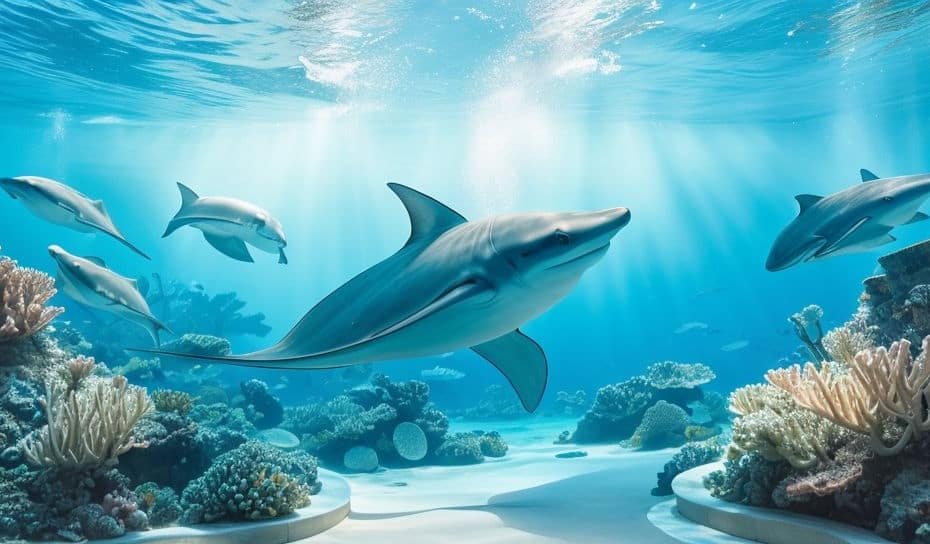Raising stingrays in a home aquarium is a thrilling and rewarding experience. They draw attention with their captivating movements and looks. You can observe their behaviors closely and learn more about their habitats by creating a suitable environment.
Stingrays are beloved for their beauty and grace. As they swim, their shapes and designs attract the eye. Plus, we can study their behavior and help scientific research in a controlled setting.
You can make a tailored habitat for them to match their natural one. Choose the tank size, temperature, salinity levels, and substrate composition carefully. Live plants or rock formations can also simulate their natural surroundings.
Filtration systems, lighting requirements, and feeding habits must be taken into account for successful stingray keeping. Offer them varied foods like shrimp, fish fillets, or squid for health and happiness. Monitor the water parameters too.
Pro Tip: Talk to experienced hobbyists or aquatic experts before starting. They can help with tank setup, compatibility with other fish, and ongoing maintenance tasks. This way, you’ll ensure your stingrays’ well-being.
Understanding the basic requirements for raising Stingrays
Raising Stingrays requires specific needs to be met. Make sure their environment is healthy and thriving!
Set up a spacious aquarium with a sandy substrate. Keep the water’s temperature and pH stable. Feed them live foods like shrimp, fish, and crustaceans for a nutritious diet. Filtration and regular water changes are a must for optimal water quality. Research the species of Stingrays you plan to raise to provide the best care.
Now that you understand the basics, it’s time to begin this amazing journey. Don’t miss out on seeing the grace of these aquatic creatures in your own home aquarium!
Setting up the perfect home aquarium for Stingrays
Tank Size: 70 gallons.
Filtration System: Canister filter with UV sterilizer.
Water Conditions: pH 6.5-7.5, Temperature 75-82°F, Hardness 8-12 dGH.
Remember to give Stingrays enough space to swim. Provide them with hiding spots like caves or PVC pipes. Feed them protein-rich foods, such as shrimp, clams, and fish.
John, a dedicated hobbyist, transformed his living room into an underwater paradise for Stingrays. His hard work paid off when he saw baby Stingrays being born in his tank!
Raising Stingrays in a home aquarium is daunting, but it can be an amazing experience with the right knowledge and dedication. Create a perfect habitat and experience the wonders of the underwater world!
Choosing the right Stingray species for your home aquarium
Selecting the ideal Stingray species for your aquarium can be tough, yet rewarding. Stingrays are captivating animals that require specific habitats to live well in captivity. Here is a table of Stingray species and their features to help you choose:
| Species | Size | Diet | Temperament | Tank Size |
|---|---|---|---|---|
| Freshwater Stingrays | 12-24 inches | Carnivorous (feeder fish, shrimp, and squid) | Shy and peaceful | 500+ gallons |
| Motoro Stingrays | 14-18 inches | Omnivorous (pellets, worms, insects) | Mild-mannered and sociable | 150+ gallons |
| Black Diamond Stingrays | 16-24 inches | Carnivorous (small fish, crustaceans) | Aggressive and territorial | 500+ gallons |
It’s essential to note that every species has its own care needs. Freshwater Stingrays do better in soft water with neutral pH levels. Motoro Stingrays prefer slightly acidic water. Black Diamond Stingrays need sandy substrates to protect their sensitive undersides.
Stingrays have been in humans’ minds for thousands of years; they are on cave paintings and pottery and are also symbols of power and grace in Mayan culture.
Now you are ready to choose the best Stingray for your tank. Remember to give them the best conditions and care to make sure they stay healthy and bring beauty to your watery environment.
Feeding and nutrition for Stingrays in a home aquarium
For keeping Stingrays healthy in a home aquarium, feeding and nutrition are essential. A balanced diet is crucial for their well-being. Here’s a table to help understand their dietary needs:
| Food Type | Frequency | Amount |
|---|---|---|
| Live Foods | Daily | 2-3% body weight |
| Pellets | Alternate Days | 1% body weight |
| Frozen Foods | Twice a Week | As per package |
| Vegetables | Once a Week | Small portion |
Live foods such as shrimp, worms and small fish should also be included. Take the size of the stingray into consideration when deciding how much to feed. Don’t overfeed.
I once had a stingray named Ray. He was very picky with his food. He would only eat pellets. It took a while to find the one he liked. Seeing him enjoy his meals was so satisfying.
Follow the guidelines above. Consult an expert or do extra research for specific dietary needs based on the stingray species. Proper nutrition is key to a healthy stingray in a home aquarium.
Creating an ideal environment for Stingrays
Creating the perfect habitat for Stingrays entails focusing on particular details that will boost their wellbeing. It is important to always monitor the water’s pH levels, staying within a range of 7.0-8.4.
Incorporating hiding spots with rocks or plants is great for Stingrays, as it offers them security and allows them to engage in natural behaviors like burrowing.
Adding a sandy substrate that mimics their natural environment is also a good idea, allowing Stingrays to partially bury themselves if desired.
Regular water changes are essential for optimal health, as they help remove toxins and preserve oxygen levels in the aquarium.
Providing a balanced diet with proteins from shrimp, krill, and fish and feeding once or twice a day without overfeeding ensures healthy growth and beautiful colors in Stingrays.
By following these tips and providing an optimal environment for your Stingrays, you can aid in their well-being and happiness while establishing a flourishing aquarium ecosystem.
Maintenance and care routine for Stingrays in a home aquarium
Caring for stingrays in an aquarium requires great attention. Here’s what to look out for:
- Water Quality: Clean, filtered water with pH levels that suit them.
- Diet and Feeding: They are carnivorous – give them small portions of live or frozen food several times a day.
- Tank Size: It must be big enough for their current size and their adult size.
- Habitat Enrichment: Hiding spots, rocks, plants, and sand give them an environment like their natural one.
Remember, stingrays give birth to live young, not eggs.
One aquarist’s experience was remarkable. As they neared the tank with a net to scoop out debris, the stingray explored it with curiosity, not fear. It seemed to enjoy the net’s gentle touch! This showed the trust that can form between the stingray and its keeper when it gets the proper care.
Potential challenges and troubleshooting tips
Want to keep stingrays in your home aquarium? Here are some tips to ensure their well-being!
- Water quality is key. Test and maintain pH levels, temperature, salinity, filtration and circulation.
- Feed them fresh shrimp, fish and suitable pellets in the right amount.
- Stingrays are sensitive to stress. Don’t make too much noise, provide hideouts and don’t overcrowd the tank.
For a better experience, give them lots of swimming space and a sandy substrate. Light it up to show off their beauty!
Conclusion: Enjoy the beauty and uniqueness of Stingrays in your home aquarium
Keeping stingrays in your home aquarium is a great way to admire their beauty and uniqueness. Let’s explore how to provide a safe environment for them!
- Give stingrays enough space to swim and show off their graceful movements.
- Ensure the water is clean with efficient filtration and maintenance.
- Provide a balanced diet of protein and plant matter.
To make the aquarium even more inviting, add natural elements like rock formations or plants to mimic their natural habitat. This will make it easier for them to settle in.
Pro Tip: Monitor the temperature and pH levels of the water to ensure the health of your stingrays.
Frequently Asked Questions
1. Can stingrays be kept in a home aquarium?
Yes, it is possible to keep stingrays in a home aquarium. However, it requires a large tank with specific water conditions and proper filtration.
2. What size tank is needed for keeping stingrays?
Stingrays need a tank that is at least 200 gallons in capacity. They require a lot of swimming space and a wide bottom area for digging.
3. What are the ideal water conditions for stingrays?
The ideal water conditions for stingrays include a temperature between 75-82°F (24-28°C), pH level around 7.0-7.5, and a hardness between 6-10 dKH.
4. What should I feed my stingrays?
Stingrays are carnivorous and feed on a diet consisting of live or frozen foods. You can offer them small fish, shrimp, worms, and squid. It is essential to provide a varied diet to ensure proper nutrition.
5. How do I ensure proper filtration in the aquarium?
Stingrays produce a lot of waste, so a high-quality filtration system is necessary. A combination of mechanical, chemical, and biological filtration is recommended. Regular water changes are also important to maintain water quality.
6. Are stingrays suitable for beginners in the aquarium hobby?
Stingrays are not recommended for beginners. They require advanced knowledge and experience in aquarium keeping. It is important to research and learn about their specific care requirements before considering keeping them in a home aquarium.

